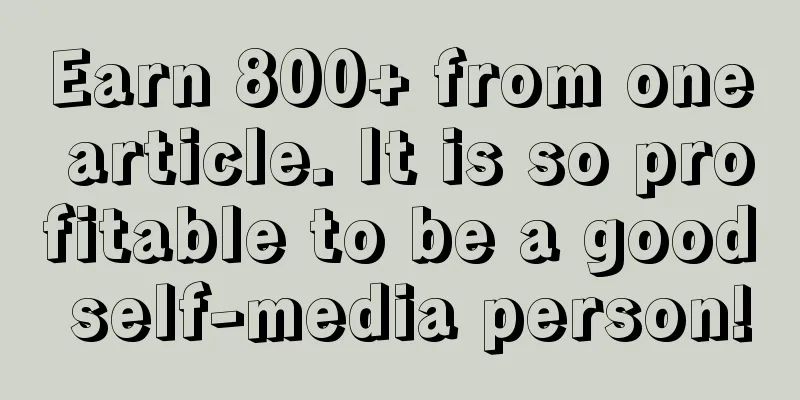Understand in one article! 36 Xiaohongshu operation thinking models [V3.0 collection series]
![Understand in one article! 36 Xiaohongshu operation thinking models [V3.0 collection series]](/upload/images/67e781056ade0.webp)
1. Xiaohongshu Operation1. Xiaohongshu advertising methodologyIt is formed by combining the analysis of official selling points with the help of traffic boosting tools, from categories to positioning to reach, and finally amplifying traffic, forming the brand strategy of Xiaohongshu in the Xiaohongshu system. Figure 1: Heterogeneous Identification Methodology
2. Panorama of blogger operationsThis picture was originally created by us. It consists of steps from blogger positioning, monetization design, in-depth positioning to specific topic selection, account creation and shooting, adjustment, etc., which truly helps IP find its own positioning and monetization methods, thereby becoming a well-known blogger, top blogger and cross-category operator. Figure 2: Panorama of blogger operations 3. Demands for different stages of deliveryReference News breaks down the needs of Xiaohongshu for seeding
Figure 3: Brand appeal at different stages 4. Xiaohongshu IDEA MethodologyThe IDEA model is a marketing thinking tool officially proposed by Xiaohongshu. It helps brands grow on Xiaohongshu through four steps: insight, definition, expedition, and advocate. Figure 4: IDEA methodology Insight: Insight into demand. With the help of Xiaohongshu’s official tools, users leave data on Xiaohongshu to help brands understand demand, find the right track, and determine what kind of user mind the product will hit; Define: Define the product, including product naming and core selling points. With the help of experts and new product trial tools, help customers define product selling points and promotion points, and prepare for the first round of MVP testing. Expand: Seize the track. Expand not only refers to increasing sales, but also pays more attention to improving the brand in categories and user minds. At this stage, through the information flow and search tools of Xiaohongshu, seize the category SOV and gain a higher market share; Advocate: advocate for the brand. When users use a good product and have a good experience, they will share it for the second time. The brand can accumulate content. At the same time, the brand can use Xiaohongshu brand advertising, such as flame topics, splash screen ads, commercial topics and other tools to gather brand content and advocate for the brand. 5. Calculation of ROI of Xiaohongshu e-commerceExcerpt: Rocket Big Data uses CPE (likes + favorites + comments + follows) as a measurement indicator for off-site ROI conversion. If you spend 10,000 yuan on Xiaohongshu and get 2,000 interactions, then the CPE cost is 5 yuan. By monitoring the T indicator, which is the ratio of Taobao searches to Xiaohongshu interactions, we can get the ratio of Taobao searches to Xiaohongshu interactions. For example, if 2,000 interactions bring 10,000 searches to Taobao, then the value of T is 5. Measure the brand keywords through business cards, product sales and shopping as well as free traffic within Taobao. At this moment, measure the transaction volume, which is S search volume × conversion rate. The transaction volume will give the transaction amount, which is the transaction volume × average order value. Finally, through conversion attribution, see the final correlation coefficient. Figure 5: Xiaohongshu conversion ROI system 6. 531 Information Flow Hot Articles Creation ModelBy using more than 5 types of notes and going online in the information flow, you can quickly identify the note style type. Then, use 30% of your energy to create potential hot articles, and 10% of your energy to focus on hot article notes for added recommendations. Find notes with high search returns and that can drive traffic outside the site. The 531 hot article core model is formed by continuously filtering high-quality article notes. Figure 6: 531 Hot Articles Model 7. Consumer Cognition ModelThis model was proposed by Feiyang in Growth. Currently, Douyin seeding is mainly based on content. Whether it is a corporate account or a KOL, it is mainly divided into two steps: depositing money and withdrawing money: The money-saving actions include planting grass + mental brand building, and the money-withdrawing actions include traffic and store live broadcasts. For brand planting, both aspects must be balanced. If you only plant without harvesting, you cannot make a profit. If you only harvest without planting, it will be difficult to sustain, and you need to maintain a balance in the end. Figure 7: Consumer Cognition Model 8. T+H chain transformationT+H Tmall and Xiaohongshu sales conversion, Tmall conversion brought by Xiaohongshu marketing. Xiaohongshu content < Xiaohongshu exposure < reading volume < interaction volume < Tmall visitor volume < Tmall transaction volume. This is a whole marketing pipeline. The data of each link can be recorded, continuously analyzed and compared. If the data is good, analyze the reasons. If the data is bad, analyze the reasons. 9. Four quadrants of blogger positioningThrough the four quadrants of positioning, you can sort out your own positioning, starting from who I am, what I have done, what I have made, and what I share on Xiaohongshu, so as to determine your own positioning on Xiaohongshu. Figure 8: Example of Xiaoxin’s four-quadrant positioning Who am I: Refine your basic information, including nickname, gender, age, living status, values, etc. The more detailed the better. The more content, the more directions you will have for selecting topics later. What I have done: Summarize my past experiences, the highlights of my work and life, even the failures; What I have accomplished: In the past, what content have I done? For example, if you are in the mother and baby sector, you can highlight your expertise in taking care of children. If you are a knowledge blogger, you can write about the projects you have done from 0 to 1. What I share on Xiaohongshu: What content do I want to share on Xiaohongshu, how to monetize it in the future, and evaluate whether I can continue to update. If I am a knowledge blogger, what products have I polished and how to package and sell them. 10. Blogger 360-degree positioning modelAccording to Ogilvy's positioning model, blogger positioning is divided into eight parts: output content, identity role, presentation form, personality tone, monetization path, memory point and benchmark selection, and core track. Each part is refined to determine the IP positioning. Figure 9: Blogger 360 Positioning Model 11. 10-3-1 Red Book Topic SelectionLu Bai proposed the 3-10-1 model in "The Hot Little Red Book". If you are not sure what type of writing style to choose, you can choose 3 fields, then find 10 currently popular notes, and then organize them into documents, imitate and create, and finally choose a field that suits you and continue to delve into it. For bloggers or brands who are unclear about their own positioning, they can choose multiple fields and organize the popular articles on the market into a table. Imitation is the greatest innovation. Imitate first, and then find a note-taking style that suits you better and create corresponding popular articles. Figure 10: Xiaohongshu’s hot-selling topic database 12. Xiaohongshu title creation formulaThe upper limit of Xiaohongshu title is 20 characters. Secondly, the cover occupies a large space, and the title occupies relatively less sight. The stimulation to user attention is second only to the cover. The title is the second most stimulating force of Xiaohongshu notes. When creating titles, you can randomly combine target groups + problems + solutions + emotional value + action instructions + colloquialism. The target group refers to the people who use the product, the scenario refers to the product usage scenario, the solution refers to the digital solution, the emotional value refers to the degree of liking expressed, the action instruction refers to asking users to use it, and the colloquialism refers to the entire title, which is easy to understand and can be understood by users for dissemination. Figure 11: Xiaohongshu universal title formula 13. Text creation total-part-totalThis is the most commonly used structural method for writing the main text of Xiaohongshu. It conforms to readers' reading habits and can also clearly express product views. Summary: Summarize the main points, express your experience of using the product, and bring about specific and substantial changes; Points: Clearly express the reason for achieving this effect and which ingredients of the product achieve it; Summary: In summary, call on everyone to buy this product and the corresponding purchasing channels. 14. Review of advertising campaigns for different brandsOn Xiaohongshu, merchants are mainly divided into voice-based, ROI-based and lead-based merchants. The evaluation standards and different stages for each type of merchant are different. Volume type: The volume type emphasizes brand awareness. During the content exploration period, it focuses on click costs, interaction costs, and hot articles. During the volume enhancement period, it focuses on recovery rate and position occupancy. ROI type: Special emphasis is placed on the conversion of products inside and outside the site. During the note testing period, attention is paid to click costs and CTR. During the product testing period, product access rates and architecture costs are assessed. During the harvest period, emphasis is placed on GMV and ROI conversion. Lead type: For customers who receive private messages, during the material testing period, pay attention to the click cost and click rate. During the mind occupation period, pay attention to the number of private message openings and the number of forms. Finally, during the cost optimization period, pay attention to the form cost and private message cost. Figure 12: Advertising review model for different brands 2. Media Communication1. Media Communication ModelIn "Marketing Management", Philip Kotler defines the communication process as consisting of nine major elements: sender, receiver, information, media, encoding, decoding, reaction, feedback and noise. In order to spread their information, marketers must consider how the target will decode it when encoding the information. H&H directly abstracts itself into sender and receiver. Encoding is what H&H often calls super symbols. After the media gives it to the receiver, it adds a psychological defense line. All the work in communication is to lower the user's psychological defense line and enable them to accept the communication content more quickly. Figure 13: Media Communication Model 2. AISAS modelFigure 14: AISAS model The AIASS model is a consumer behavior analysis model summarized by Dentsu in response to changes in traditional shopping behaviors caused by the Internet. For Xiaohongshu, each indicator can be reviewed. High-quality notes must receive enough attention and high clicks from users, and then be searched on and off the site, and ultimately be shared, achieving a word-of-mouth effect.
3. A/B TestingA/B Test is to control the same variables and conduct tests to see which one works better. For example, when placing ads on Xiaohongshu, different articles will be selected, and the same time, region and audience will be set for targeted placement to see the data changes between the two. If the data performance of one side is much higher than the other side, the notes with good data will continue to be placed. 4. Maslow's Pyramid of Needs TheoryValue must be based on user needs. When talking about user needs, we have to take out Maslow's hierarchy of needs. Safety and physiological needs remain at the functional level and belong to the material level, while social, respect and self-realization are concentrated on the spiritual level. Xiaohongshu's marketing mainly focuses on social, respect and self-realization needs. Figure 15: Maslow's pyramid needs theory model 5. Eight major groupsIn 2019, Alibaba proposed eight major groups, dividing the consumer groups into small town youth, urban GenZ, urban white-collar workers, sophisticated mothers, urban middle class, urban blue-collar workers, urban silver-haired people, and small town middle-aged and elderly people. First: Small town youth They are young men aged 20 to 30, mainly living in fourth-tier cities and below. They have less mortgage pressure, considerable disposable income, and more leisure time, which means they have enough time and financial resources to manage their own lives, and most of them focus on entertainment apps. Second: Generation Z The majority of them are students, born in 1995/2000, living in first-, second- and third-tier cities. They are Internet natives who are keen on online shopping and there seems to be no more attraction to attract them to shop in stores. Third: Exquisite Mom They are mainly pregnant mothers or young mothers with children under 12 years old, who mainly live in first-, second- and third-tier cities and have strong purchasing power. They care about their children's growth and pay attention to the health and safety of products; they love their children while loving themselves and pay attention to their own health and maintenance; at the same time, due to their high education, they are the guardians of the health of the whole family and the decision makers of purchases. Fourth: New white-collar workers This group of people is mainly concentrated in the age group of 25 to 35 years old. They usually live in first-, second- and third-tier cities. They are mainly company employees, civil servants, financial practitioners, etc. and have strong consumption power. Fifth: Senior middle class This group of people is mainly concentrated in the age group of 35 to 45 years old. They usually live in first-, second- and third-tier cities. They are mainly company employees, civil servants, financial practitioners, etc. and have strong consumption power. Sixth: Urban Blue Collar The population is mainly concentrated in the age group of 25 to 45 years old, and usually lives in first-, second- and third-tier cities, but their consumption capacity is not as good as that of the two consumer groups of new white-collar workers and senior middle-class people. Seventh: Urban Silver Hair People over 50 years old living in first-, second- and third-tier cities, the traditional people born in the 1960s and 1970s, are different from the new white-collar workers. They are the "invisible gold mine" in the Internet era, but the concept of frugal consumption is still deeply rooted. Although they are heavy users of instant messaging (i.e. WeChat, QQ, etc.), their consumption is still mainly offline. Eighth: Middle-aged and elderly people in small towns They are mainly people over 35 years old living in fourth-tier cities and below. They are deep followers of consumption, pursue ultimate value for money, and focus on socializing with acquaintances. Because of the existence of this group of people, most stores that rely on customer relationships still have value and necessity. 6. The Rule of SevenThe seven-time rule means that users will only be willing to learn about your brand and trust you after seeing you seven times in a row, and then buy your products. The same is true for advertising. After being influenced seven times, there will be some changes. So there are about seven times for advertising. Figure 16: The Rule of Seven 7. Changes in media communicationThe chart below is from the changes in Hua & Hua's communication forms. In ancient Greece, information was spread through rhetoric, then through propaganda during World War I and World War II, and through advertising after World War II. Later, it entered the era of mass communication and used television mass media for communication. After the emergence of the Internet, one-to-one communication was used. Currently, communication with consumers is carried out through algorithms, such as push notifications on Douyin and Xiaohongshu through account tags. In H&H's understanding, this form of communication should be done in the opposite way, from push to rhetoric, focusing on ancient Greek rhetoric. Whether it is the creation of brand proverbs, it conforms to the principles of rhetoric and rhyme. This is also a new idea for advertising practitioners. Figure 17: Changes in the form of communication 3. Brand Marketing1. Kenichi Ohmae's 3C modelFigure 18: Ohmae Kenichi 3C Model Kenichi Ohmae, a leading figure in Japanese strategic research, proposed that a successful strategy must take into account three aspects: the company itself, its customers, and its competitors. Only when the company, its customers, and its competitors are in the same strategic system can customers gain sustainable competitive advantages.
2. Brand Triangle ModelFigure 19: Brand triangle model The brand triangle model was proposed by H&H as a tool to help us better understand brands. The bottom layer is the product, that is, the structure of the product. The left side is the brand proverb, including business theory, product science, brand discourse and corporate culture; the symbol system on the right side is the super symbol. Every customer who wants to promote a product on Xiaohongshu should first think about whether the product structure is reasonable and competitive, and then consider whether the discourse system is appropriate and whether there are any advertising slogans and promotional slogans. Then consider whether it is possible to make users retain their knowledge, form memories, and achieve the effect of communication. Only after these three issues are considered clearly can you truly succeed in planting grass on Xiaohongshu. 3. 4P Marketing Theory4P is the whole of marketing, and the core elements of marketing revolve around 4P. During the operation of Xiaohongshu, we should not only consider the specific methods of writing articles, but also revolve around the 4P theory of marketing. Figure 20: 4P Marketing Theory
4. STP TheorySTP, namely market segmentation, target market and market positioning, constitute the three core elements of each company's marketing strategy (STP for short). Simply put, you can't do business with everyone, so you must choose a niche market, provide subdivided products, and gain competitive advantage from this niche market. For example, in the automotive field, Haval is in the family SUV market segment, Wuling is in the affordable family truck market, and Porsche is in the high-end sports car market. The market segment is not the core. The core is the competitive advantage to be gained in this market. How to gain competitive advantage through market segmentation? The first point is to enter a market with high user demand and few competitors. The second point is to carry out strategic positioning around the market you enter, to provide products and services that truly address the needs of this part of users, and to gain advantages in operating and designing this market segment. 5. Horizontal MarketingHorizontal marketing is a horizontal creative thinking method relative to vertical marketing. It reorganizes products by developing new uses for existing products, creating new scenarios and locking in new targets. Horizontal marketing is a creative process, more suitable for the divergence of creative content, a kind of creative thinking, and a necessary supplement to vertical marketing. In other words, horizontal marketing is not a replacement for vertical marketing, but a new way of thinking when the market is deadlocked. Horizontal marketing is divided into 3 steps:
6. Brand Five Forces ModelFigure 21: Brand Five Forces Model Brand power is a comprehensive expression, mainly covering product power, channel power, marketing power, management power and brand power.
7. SWOT AnalysisFigure 22: SWOT analysis Based on the situation analysis under internal and external competitive environment and competitive conditions, the main internal strengths, weaknesses, external opportunities and threats are listed through investigation. This method can be used to analyze and summarize the strengths and weaknesses of the enterprise.
8. Porter’s Five Forces AnalysisFounded by Harvard University professor Michael Porter in 1979, it is a competitive strategy analysis method to determine the degree of industry competitiveness. The five forces are mainly divided into the bargaining power of suppliers, the bargaining power of buyers, the ability of potential competitors to enter, the substitution power of substitutes, and the current competitive power of competitors in the industry; Figure 23: Porter’s Five Forces Analysis
9. FAB Benefit Sales LawThe FAB benefit sales method is to selectively and purposefully persuade customers with one reason after another when introducing products, sales policies, and sales details. Figure 24: FAB Profit Sales Method
10. The eight incentives model for copywriting
4. Work Awareness1. OKR goal management modelOKR is the abbreviation of Objective Result. Many companies are using it, such as Xiaohongshu, Alibaba, Google, etc. It is a task management method that is centered on objectives and key results and can help us better clarify our goals, using this week's tasks and subsequent tasks as auxiliary. Figure 25: OKR goal management model How to formulate an effective OKR:
For example: For example, the goal is to "become a dandelion expert in one month" Key results: 1. 5,000 followers; 2. No violations in the account; 3. High-quality content in the account Then add a confidence index (5-10 stars) to each task, indicating the confidence level in completing the task. 8 stars means 80% confidence. 2. Six-step method for data analysisFigure 26: Six-step method for data analysis
3. 3W Golden Circle RuleFigure 27: 3W Golden Circle Rule What to do [What] refers to what to do specifically, and refers more to the execution level, specifically to how to accomplish it. How 【How】through which aspects, that is, to solve this problem and how to better achieve the goal. Why? In the process of operating Xiaohongshu, many brands also provide good product experience, but they are not clear about what substantial benefits they can get from good product experience. Good product experience can let official influencers give feedback on the advantages and disadvantages of products, continuously adjust product design, and allow brands to continuously upgrade products. 4. Pyramid PrincipleThe pyramid principle can be used to refine the main text or selling points of Xiaohongshu. The principle is that anything can be summarized into a central argument, and this central argument can be supported by three to seven arguments, and these arguments are also supported by data, which are linked together, allowing users to have absolute trust. For example, if an eye cream claims to be the best at adherence and the savior of powder sticking, to prove this claim, it can point out which elements in its ingredients can achieve adherence, and the specific reasons why these elements achieve adherence need to be clearly informed to users so that the proof is more complete. 5. PDCA working principlePDCA means that every work needs to go through four stages: planning, executing the plan, checking the plan, adjusting the plan and constantly improving it. You can learn more about it from Tomita Kazunari's "Efficient PDCA Work Technique" Figure 28: PDCA working principles
The above is Xiaohongshu's operation tool V3.0. During the operation process, you will definitely encounter specific operation model scenarios and then disassemble the model to understand its operational essence. Author: Jianghe Team Source: WeChat public account "Jiangheliaoyingxiao (ID: jiangheliaoyingxiao)" |
>>: 10 rules for World Cup marketing
Recommend
Brands are closing down one after another. Here are 11 suggestions for new consumption to find a way out.
Recently, we have heard news of brands going bankr...
Is it safe to advance payment through Shopify? How to pay through Shopify?
Shopify is a platform for sellers to build e-comme...
Adults "cat and mouse": young people are "socializing in silence"
An adult version of “Cat and Mouse” with running a...
A tea brand "Yinian Caomuzhong" private domain growth case analysis, worth learning for everyone
At present, the development of the tea industry is...
How to cancel after being tricked into registering on Amazon? Is there any risk in working part-time on Amazon?
Some people may be deceived by criminals to regist...
How to build a corporate strategy house?
The corporate strategy house is a basic requiremen...
Shopee Philippines to freeze accounts that repeatedly list banned products
Shopee Philippines announced that starting from Oc...
Does Amazon Europe require VAT for FBA? How to declare VAT?
Sellers who sell products on Amazon Europe and use...
How to operate physical stores in the same city?
Physical store operations face many challenges, su...
Correctly understand brand awareness
Brand awareness can make customers recognize and r...
What is a data analysis project and how to do it?
Many students who are responsible for data will wa...
Online customer acquisition is no longer about content IP, "building a brand's online ecosystem" is the trend
This article introduces in detail how to build a b...
Children's Day Marketing: How Brands Can Make Money by Being Cute
The article comprehensively explains the reasons, ...
Where can I find Amazon's conversion rate? How can I increase Amazon's conversion rate?
The conversion rate of a store is an important fac...
What is the registration process for a Shopee local account? How much does it cost?
Now many cross-border e-commerce platforms have lo...









